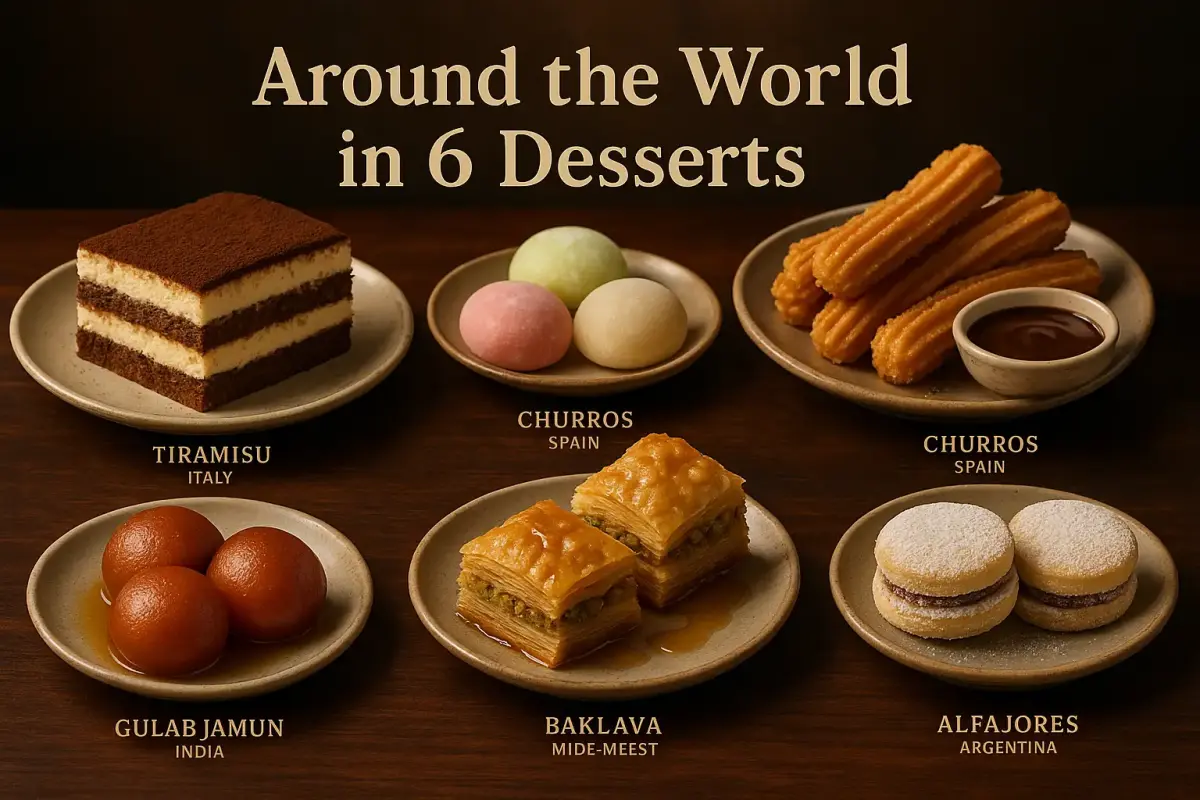Savor your way through the sweet stuff from Italy’s tiramisu to Japan’s mochi — all from your home kitchen.
Desserts have a way of bridging culture, a sweet language that is shared by all. Whether a luscious chocolate cake or flaky pastry, sharing dessert is something everyone can do, no matter where one lives. Embark on a world tour with these six international desserts that will give you a little taste of home. And the best part is most of these treats can be made at home!
1. Tiramisu (Italy)
Tiramisu is one of Italy’s most-known desserts for a reason: It is a work of culinary magic, blending together coffee-drenched ladyfingers with a velvety mascarpone cream and a generous dusting of unsweetened cocoa powder—it’s not too sweet, not too bitter and sweet enough to be, well, dessert. Leaving the country and heading east, and Japan’s mochi-balls are a delightful contrast of texture being chewy rice-cakes wrapped around sweet fillings like red bean paste or matcha flavoured cream – the perfect, elevating flavor experience, in keeping with the Japanese value placed on harmony and simplicity.
At home, just pile together the dressing while it’s layered and let it marinate overnight in the refrigerator to get all the flavors into play. Tiramisu, a classic Italian sweet, perfectly characterizes the medley of tastes and textures, which have made it one of the most popular desserts around the globe. Hailing from the Veneto region, this extravagant treat boasts layers of coffee-soaked ladyfingers and rich mascarpone cheese for a taste experience that's at once decadent and delicate. A sprinkle of cocoa powder on top not only gives it good looks, it adds a hint of bitterness that makes a good pairing with the sweet flavors.
One of the best things about tiramisu is that for something so luxurious and sophisticated tasting, it requires absolutely no baking and can easily be made at home. By giving the dessert an overnight stint in the refrigerator, each layer of cream and cake soaks up and harmonizes with the others to form a dense tapestry of flavors that's as soothing as it is refined. Served at a supper club or on a Tuesday night at home, tiramisu is the epitome of Italian dining brilliance at every spoonful.
2. Mochi (Japan)
Auspicious Mochi is a chewy rice cake that has become synonymous with Japanese sweets. This dessert, which is made with glutinous rice flour (often mochiko) can be filled with sweet red bean paste, or plain. The process of making mochi at home involves steaming a dough into smooth pliancy, shaping it into little balls.
One of the most popular treats in Japanese cuisine is Mochi, which is a squishy rice cake that fulfills both cultural and palatable aspects. Popular in Japan is mochi, made with a type of glutenous rice flour known as mochiko, which lends the mochi its chewy texture. This easy to make sweet can be eaten plain or stuffed with sweet red bean paste, impart a delicious sweetness to its sticky exterior.
Making mochi at home first requires steaming it until it's softened into a pliable, smooth ball, which can then be deftly formed into little balls. The preparation does take endurance and skill to reach the desired perfect texture, how the end product is wonderfully fulfilling and encompasses the flavors of Japanese canan cuisine. More than just a sweet treat, mochi is a key player in Japanese festivals and ceremonies, and represents prosperity and good luck.
For nearly two decades now, whether people have enjoyed mochi at new year celebrations or at an everyday treat, they can’t seem to get enough of its chewy texture and cultural significance.
3. Churros (Spain)
Churros are those crunchy, fried bits of dough love served alongside a cup of thick hot chocolate for dipping. From Spain, these lovelies are piped into hot oil until golden brown. Dust them with cinnamon sugar for addictive bites worthy of sharing.
Since first created, Churros are a favourite in Spain, they are traditional fried pasty that have delighted food enthusiasts all over the world for centuries. Those nuggets of happiness are classic with a cup of thick, Spanish-style hot chocolate, a nice contrast of crunchy churro with smooth dip.
Churros Making: If you are making churros, then heat oil and pipe the dough directly into the hot oil for the perfect light and airy insides with a delicious crisp outside. These sugary fried treats are commonly dusted with cinnamon sugar, and they bring the perfect balance of both sugary sweetness, and delicate flavors.
Originating in Spain, these pastries have crossed over a variety of borders and have been adapted by many different cultures in their own way. Whether passed around between pals, or noshed on solo as a decadent sweet treat, the joyous shape of the churro remains a culinary emblem of glee and cultural depth across the world.
4. Gulab Jamun (India)
Gulab jamun is a sweet dessert that is made up of deep-fried dough balls and is deliciously soaked in cardamom and rose flavoured sugar syrup. To cook it at home, a simple dough of milk powder or khoya is fried until golden and then soaked in syrup for a heavenly taste.
Gulab jamun is a popular Indian sweet made up of a perfect mixture of deep-fried, milk-based dough soaked in sweet, sticky sugar syrup. This sweet consists of deep-fried balls of dough that are usually based on milk powder or khoya, a form of dried milk. The dough is then delicately molded into little balls and fried to a golden brown that provides the exact proportion of crunch on the outside, softness on the inside.
After frying they are soaked in a fragrant, cardamom and rose water scented sugar syrup, which adds flavor and fragrance with every bite. This overnight soak ensures the sweet isn’t just sweet, but also wears a gentle whisper of flowers on its spring sleeve.
Preparing gulab jamun at home is a rewarding culinary experience that brings a hint of India’s rich cultural tapestry to your kitchen and offers an indulgent treat for beginner and experienced cooks.
5. Baklava (Middle East)
A type of filled with chopped nuts and sweetened with honey or syrup sweet pastry is called baklava. This Middle Eastern classic takes patience but pays back with flaky crispness and the kind of nutty, prolific sweetness that a tube of store-bought rosewater pastry cannot. Layer buttered filo with nuts, bake to crispness, and douse in syrup.
Baklava is a cherished dessert all over the Middle East, known for its layers, flavors and the time and process it takes to make it. This confection is produced by layering paper-thin sheets of filo with lots of freshly ground nuts (usually pistachios, walnuts or almonds). The layered pastry is then baked in the oven until golden then saturated with honey or some sort of syrup that brings out its sweetness and melds the layers into one.
Making baklava requires a lot of time and a very even hand with the butter, each layer needs to be thinly buttered to achieve its trademark flakiness. The payoff for the effort is a symphony of textures and flavors: flapping filo against crunchy nuts wrapped up in sticky sweetness.
Baklava’s rich flavor has secured its place on desert tables at festive occasions and events across the Middle East, providing fans to this day with ample reason to enjoy its charms.
6. Alfajores (Argentina)
Alfajores are tender sandwich cookies from Argentina that are filled with luscious dulce de leche, and are typically rolled in coconut or dusted with powdered sugar. To make these at home, bake shortbread-like cookies and sandwich plenty of dulce de leche between them for a melt-in-your-mouth treat.
Alfajores, a traditional Argentine treat that is so popular thanks to its soft and mellow texture. These sandwich cookies are a treat, made with two buttery shortbread-like cookies with a healthy dollop of creamy dulce de leche, a perfect marriage of sweet and salty, that just melts in your mouth with each bite.
Dusted with a bit of powdered sugar or rolled in shredded coconut and they are an over the top treat of sweet and texture. Making these mouth watering cookies at home will give you the true taste of Argentine confectionery in your own home. The process entails the baking of soft cookies until they are just right, and spreading the dulce de leche gently between the cookies, which creates a sweet that is deeply satisfying and culturally enhancing.
Noel’s desire to taste global flavors in such desserts, in addition to being a delightful exercise in culinary amusement, also serves to ‘introduce the eater to some others’ traditions.’ So slip on your apron and immerse yourself: you’ll sweeten your senses in no time and experience the intimate connection between every bite of candy and centuries of culinary tradition.


